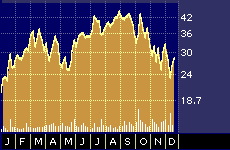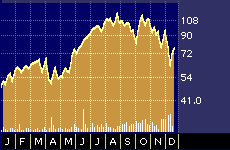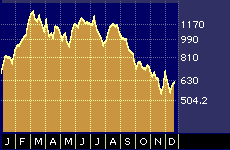
Contract Manufacturing: A Second-Half Bet (part 2)
Contract Manufacturing: A Second-Half Bet (part 2)
By Hal Plotkin
CNBC.com Silicon Valley Correspondent
Dec 28, 2000 04:03 PM
Michael Morris, an analyst with Salomon Smith Barney, based in San Francisco, also sees Flextronic’s stock going up to the mid $70 dollar range over the next 12-18 months.
“It’s really one of the best times to accumulate these stocks we’ve seen since 1998,” he says, adding that Flextronics is one of his top two current picks in the sector right now, along with recently beaten down Solectron Corporation, which he thinks is poised for a rebound by or before late next year.

One-year performance of FLEX
Sanmina Corporation’s strong list of repeat customers and healthy balance sheet is also attracting the favor of EMS analysts. The company has $100 million in the bank and currently generates approximately 70% of its revenue from sales of mostly big ticket items to customers in the highly competitive communications sector. The company’s top 10 customers, who together represent 54% of revenues, include Nortel Networks Corp. {NT}, Alcatel {ALA), Lucent Technologies Inc. {LU}, Motorola Inc. {MOT}, and Solectron Corp.
The average tenure of Sanmina’s customers is 12 years, according to the company.

One-year performance of Sanmina
“We’ve been able to attract an excellent customer base heavily focused on the communications sector,” Randy Furr, Sanmina’s president and chief operating officer told an investors conference in San Francisco earlier this year. The average tenure of Sanmina’s customers is 12 years, according to the company. “Obviously, we’ve been doing a good job of holding on to our customers,” Furr observed.
“They’ve got a solid business, it’s a proven company with a strong balance sheet and good management,” says Cage.
Cage currently has a short-term “strong buy” and-long term “buy” rating on the stock, an indication, he says, of his faith over both time periods. His current 12-month price target on Sanmina’s stock stands at $120.
Needham & Company’s New York-based analyst John McManus also tabs Sanmina and Flextronics as his two top picks in the EMS sector at current price levels.
McManus has a “strong buy” rating on Sanmina’s stock, along with a $128 12-18 month price target.
“Sanmina still has about 70% of their business in the communications sector, not handsets but infrastructure,” he says.
McManus says he still expects to see increased spending in telecommunications infrastructure as well as increased outsourcing in those markets over the coming year. He cites recent troubles at firms such as Lucent Technologies Inc. as evidence of the continued pressure on margins that drives new outsourcing business. What’s more, he says the major players will have to spend more money on telecom equipment next year just to stay in the game.
Either development would be more good news for Sanmina, while both would mean excellent news. In addition, McManus says Sanmina’s recent acquisition of Hadco Corporation {HDC}, a major printed circuit board fabricator, should allow the company to show somewhat higher operating margins in the near term.
Of course, there is more than one way to size up the situation: On Tuesday, for example, Credit Suisse First Boston analyst Mark Hassenberg cut his price target for Sanmina to $107 from $171, citing a “readjustment to the multiples in the overall industry.” The analyst nonetheless maintained his “strong buy” rating.
As a group, EMS firms are expected to post 25% year-over-year growth for the next five years, primarily as a result of the escalating trend toward outsourced manufacturing, according to First Union Securities analyst Bill Cage.
But the recent performance of many EMS stocks would seem to indicate the opposite.
“We’ve seen all this before,” contends Dunne, of Robertson Stephens. “The market is an expectational beast and in this case the expectations are largely based on what is happening to other indexes, such as the SOX [PHLX Semiconductor Index].”

One-year performance of the Philadelphia Semiconductor Index.
But history has shown that bad news for the semiconductor index has often meant good news a few quarters later for EMS stocks, says Dunne.
“We are already hearing anecdotal evidence that [manufacturers] are increasing their consideration of outsourcing,” he says. “The December and March quarters are a concern. But by the time we get to the fourth quarter [of 2001] we’re going to see another big wave of outsourcing.”


